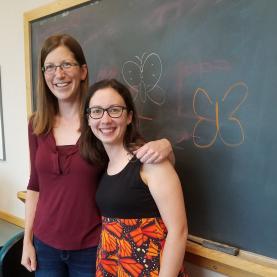How Graduate Students and Faculty Influence One Another’s Research
In nature, cross-pollination occurs when pollen from one plant is transferred to another plant, resulting in healthier offspring and new plant varieties. It’s essential for genetic variation, increasing plants’ diversity and adaptability in changing environments.
So, too, is cross-pollination essential for breakthroughs in scientific research.
Positive relationships between graduate students and their advisors have long been shown to influence the quality of students’ research and experience. Graduate faculty provide guidance, encouragement and inspiration for their students; more than half of University of Minnesota graduate students cite the scholarly reputation of a particular faculty member as one of the main reasons they chose to enroll in their program (gradSERU 2019).
What’s not always as obvious, though, is how these graduate students are impacting faculty.
Graduate students spark new research questions for faculty
Dr. Emilie Snell-Rood, associate professor in the College of Biological Sciences, knows firsthand how working with graduate students can prompt new questions and inspire faculty to explore novel avenues of research.
Emilie uses butterflies to understand responses of animals to new and stressful environments -- how do organisms adjust their development in different environments? In some early work in her lab at UMN, Emilie tested how road salt runoff influences the sodium levels of roadside plants, which, in turn, affects the neural and muscle development of the caterpillars feeding on their leaves. As with much research, this work raised more questions than it answered, so she started to seek funding to study the effects of roadsalt more broadly. Initially, her efforts were unsuccessful.
Meanwhile, one of her graduate students, Megan Kobiela – awarded her Ph.D. in Ecology, Evolution & Behavior in 2019 – had independently started research in the lab on heavy metals (like lead and nickel) and pesticides (like the neonicotinoid Marathon®). Initially, Emilie, who had no history or interest in working with heavy metals, saw Megan’s work as an interesting new direction for the lab, but didn’t see how it would change her own thinking. But as Megan talked more and more about her reserarch, Emilie started to get more interested in these pollutants and their prevalence.
New connections lead to $815,000 grant
As Emilie worked to revise and expand her road salt grant, she saw new connections to roadside heavy metals and pesticides. “It just clicked,” says Emilie. “Roadsides have such a complex suite of interacting toxins - animals may be attracted to the salt, but then suffer from high levels of metals and other pollutants.” Megan’s interests broadened Emilie’s thinking as she revised and resubmitted a grant to the Legislative-Citizen Commission on Minnesota Resources (LCCMR), pushing the ideas in new directions which eventually led to an $815,000 award. In partnership with the Department of Transportation, Emilie, her lab, and a team of UMN faculty are investigating how to maximize the nutritional health of native bees and monarch butterflies that rely on roadside habitat corridors.
“Megan also opened my eyes to underlying physiological mechanisms that allow organisms to deal with entirely new conditions,” says Emilie. Megan became a crucial contributor to a 2018 review on this topic. “Her interests and her own research inspired me to consider the many ways that dealing with one stressor might be beneficial for an organism dealing with a wide range of stressors - responses can be general.”
Pushing faculty toward uncharted spaces
A diversity of ideas and points of view is critical for research, but with all the demands on a faculty member’s time, it can be hard for faculty members to decide which new and different ideas to pursue. Regular interaction with graduate students or postdocs is frequently needed to convince faculty to move their research programs into unexplored areas. “After starting a faculty position, I quickly learned that one of the best ways to learn something new is by talking with one’s grad students as much as possible,” says Emilie. “Or find a way to go on sabbatical!”
The contributions of graduate students and postdoctoral scholars are fundamental to the University of Minnesota’s reputation as a leading research institution. While they undoubtedly benefit from the expertise and experience of faculty, graduate students and postdocs provide faculty with the opportunity to cross-pollinate ideas that stimulate growth and innovation in research.
